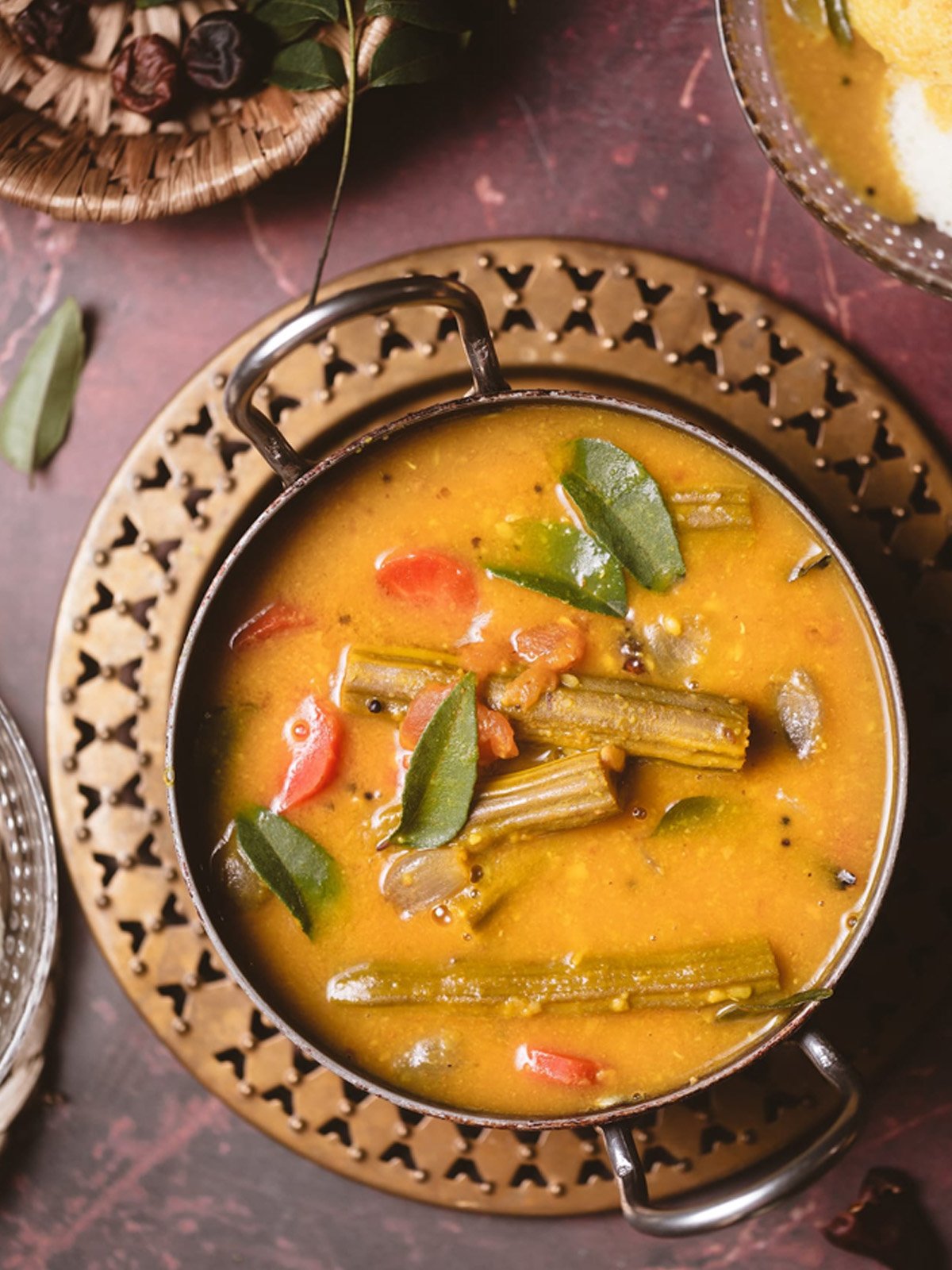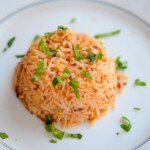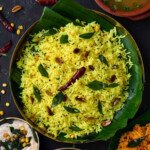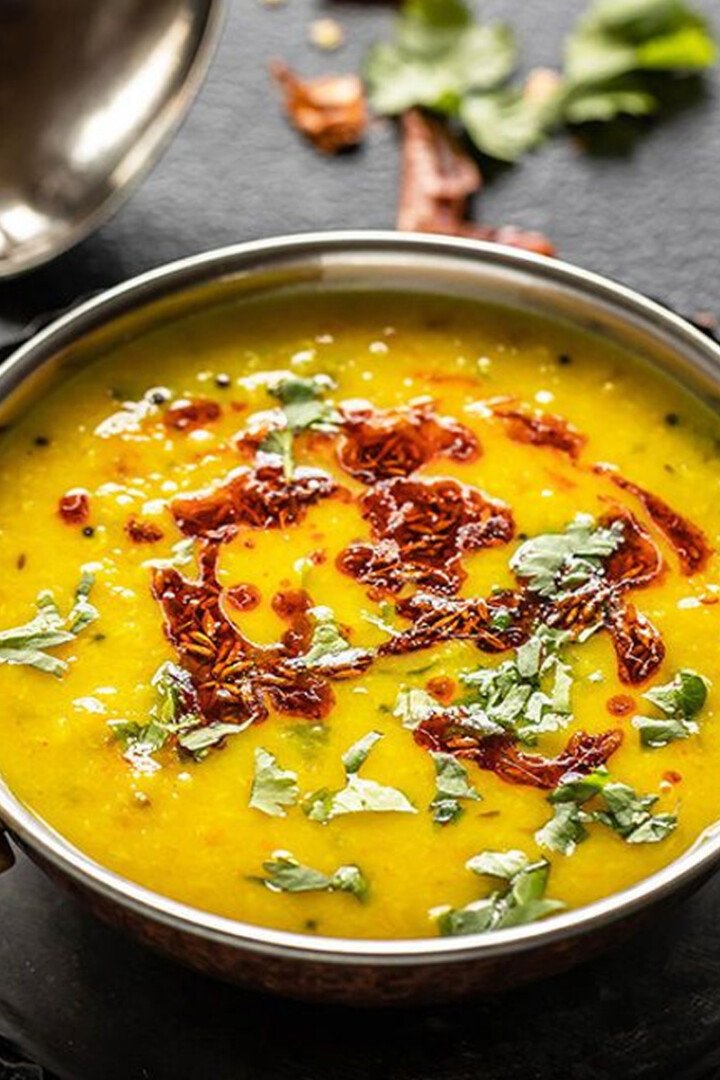Sambar is a tasty recipe and popular dish from South India 🌶️. Made with lentils and veggies 🥕🍆, it’s cooked in a spicy and tangy sauce 🍋. Not only is it flavorful, but it also has a rich history 📜. Plus, it’s filling and nutritious 💪! If you are looking for an authentic Sambar recipe, you have come to the right place.

Jump to:
- 🍲✨About Sambar Recipe✨🍛
- What is Sambar?🤔
- The Essential Ingredients for Sambar🍲
- The Perfect Sambar Base🍲
- Sambar Powder Secrets🌶️
- Cooking Techniques for Perfect Sambar🍲
- 🛒🍛What you Need to Make This Sambar Recipe🍲📝
- 🍲✨How to Make Sambar Recipe✨🍛
- 🍛🍚Pairing Dishes🍽️✨
- Creative Variations of Sambar🌶️🍲
- Health Benefits🌱🍲
- Sambar Leftovers and Meal Prep
- ❔FAQs
🍲✨About Sambar Recipe✨🍛
Sambar is a delicious recipe and hearty South Indian dish made with lentils, vegetables, and tamarind, cooked in a flavorful, spicy broth. 🌶️
It’s an essential part of South Indian cuisine, especially in Tamil Nadu, Kerala, Andhra Pradesh, and Karnataka.
Each state adds its own twist to the dish, whether it's the choice of vegetables, spices, or the level of tanginess. 🍲
Culturally, Sambar holds a special place in South Indian homes, the recipe served during meals with rice, dosa, or idli. 🍚
It’s also a festive dish, often served during celebrations. Over time, Sambar recipe has spread beyond India, loved by foodies worldwide. 🌍
From street food stalls to high-end restaurants, it has become a global favorite, enjoyed sambar recipe by people everywhere.
The rich flavors, healthy ingredients, and versatility have made Sambar a go-to dish for many! 😋
What is Sambar?🤔
Sambar is a popular South Indian dish made with lentils (toor dal), vegetables, and a blend of flavorful spices. 🌶️ Typically, it’s served alongside idli, dosa, or rice, which makes it a filling and satisfying meal. 🥣 It’s the perfect balance of taste and nutrition!
The dish has a tangy and spicy flavor, thanks to tamarind and a mix of curry leaves, mustard seeds, and other spices. 🌿 Moreover, it’s loved for its rich taste and nutritious ingredients, offering an excellent balance of protein, fiber, and vitamins. 💪 It’s both delicious and healthy!
Whether at home or in a restaurant, sambar is a beloved dish that’s both filling and tasty! 😋
The Essential Ingredients for Sambar🍲
- Core Ingredients of Sambar: The magic of sambar starts with toor dal (pigeon peas) – it makes the dish creamy and hearty! Tamarind adds that tangy zing, while mustard seeds, curry leaves, and sambar powder bring in the rich flavor. I’ll never forget the first time I added all the spices together—it was like the dish came alive! 🌿✨
- Vegetable Variations: Sambar isn’t just about dal! You can add veggies like carrots, potatoes, drumsticks (moringa), brinjal (eggplant), and tomatoes. I remember my mom once added pumpkin, and it gave the sambar a sweet twist that my whole family loved! 🍅🥕🥔
- Sambar Powder vs. Homemade Blend: While store-bought sambar powder is convenient, homemade sambar powder (with coriander, cumin, fenugreek, and dried chilies) takes the dish to the next level. I tried making my own once, and the aroma filled the house—it was totally worth it! 🌶️🌱
The Perfect Sambar Base🍲
- Cooking the Dal: First, cook the toor dal until it's soft and mushy. Be careful not to overcook it into a paste—keep it thick but smooth for the right texture. 🍛
- Tamarind and Tanginess: Tamarind plays a key role in giving sambar its signature tang. 🍋 You can easily adjust the amount depending on how tangy you prefer it, allowing you to balance the sourness perfectly to suit your taste.
- Tempering (Tadka): Finally, temper mustard seeds, curry leaves, asafoetida, and dry red chilies in hot oil or ghee. This step brings out all the spices' flavors, filling your kitchen with a fragrant aroma! 🌿🌶️
Sambar Powder Secrets🌶️
1. Homemade vs. Pre-made: I still remember the first time I made sambar with homemade powder—it was amazing! The fresh flavors made it taste so much better than store-bought. 🌿
2. How to Make Sambar Powder: Making it at home is simple! Just roast coriander, cumin, fenugreek, and chilies. The aroma is so inviting when you grind them! 🧑🍳
3. Roasting the Spices: At first, I didn’t understand the importance of roasting, but once I did, I realized how much richer the sambar tasted. It’s a game-changer! 🔥
Cooking Techniques for Perfect Sambar🍲
- Using a Pressure Cooker: I remember when I first used a pressure cooker for sambar. It was so fast! The dal and vegetables cooked in no time, keeping all the nutrients and flavor locked in. Super convenient for busy days! ⏱️
- Slow Cooking vs. Instant Pot: While I love the rich, deep flavor slow cooking gives, the Instant Pot has saved me so much time! The Instant Pot is quicker, but slow cooking brings out a richer taste—it's all about what you prefer! 🕰️ vs 🚀
- Consistency and Texture: For thicker sambar, I let it simmer a bit longer. But if I want it a little runnier, I just add some water. I remember the first time I got it just right—my family was so impressed! 😋
🌟 Craving more tasty dishes? 🤩 Check out these mouthwatering recipes:
🍚 Sambar Rice - A comforting, flavorful bowl of joy!
🥣 Oats Idli - Light, fluffy, and oh-so-healthy!
🍋 Puliodharai - Tangy tamarind rice that'll tickle your taste buds!
🍛 Dal Fry - Spicy, savory, and absolutely satisfying!
🌱 Moong Dal - Light, wholesome, and packed with goodness!
🛒🍛What you Need to Make This Sambar Recipe🍲📝
📝🍴Recipe Ingredients🥄🌿

Ingredients Notes:
- Toor Dal (Pigeon Peas) 🍲: The base of the sambar! When I cook it, I make sure it’s soft and smooth, just like how my mom always said, “Sambar isn’t sambar without perfectly cooked dal.”
- Tamarind 🍋: Ah, the secret tang! I clearly remember my aunt teaching me that adding just the right amount of tamarind is what gives the sambar its signature zing. 🍋 She always said, "Too much, and it’s too sour, but just enough, and it’s perfect!"
- Sambar Powder 🌶️: The heart of the flavor. I always use fresh homemade powder because it’s way more aromatic than the store-bought version—my dad swears by it!
- Curry Leaves 🌿: A magical touch indeed! My grandmother always said, “No curry is complete without curry leaves,” and I couldn't agree more. The moment you add them, they release a fragrant aroma that fills the kitchen, making everything smell absolutely delicious. 🌿
- Vegetables 🥕🍆: Carrots, potatoes, drumsticks—oh my! Each vegetable brings a unique taste, and I love how every bite tells a new story.
🍲✨How to Make Sambar Recipe✨🍛
📝🔪Step by Step Instructions🍴💥
1. 🌾🍲Preparing the Dal🌟🥄
- First, rinse ½ cup of toor dal under running water until the water is clear. This is important because it removes extra starch and dirt.
- Next, put the rinsed dal in a pressure cooker with 2 cups of water and ½ teaspoon of turmeric powder.
- Cook it for 4-5 whistles, or until the dal is soft and mushy. Cooking it well gives the sambar a smooth texture! Once it’s cooked, mash the dal with a spoon until smooth, and then set it aside.
2. 🍋✨Preparing the Tamarind Extract🫙💦
- Now, soak 2 tablespoons of tamarind in ¼ cup of warm water for about 10 minutes. This helps extract the tamarind pulp.
- After soaking, squeeze the tamarind to get the pulp and throw away the leftover pieces. This step is key for adding tangy flavor to the sambar!
3. 🥕🍆Cook the Vegetables🥔🍅
- Chop 1 cup of mixed veggies like carrots, potatoes, tomatoes, and drumsticks.
- Then, steam or cook them in a pot with enough water, ½ teaspoon of turmeric powder, and salt until they are just tender. This way, they keep their shape! Once the vegetables are cooked, mix them into the mashed dal.
4. 🍲✨Making the Sambar🌿🔥
- Add the tamarind pulp to the dal and veggies.
- Then, stir in 2 tablespoons of sambar powder and adjust the salt to your taste. Let it simmer for about 10 minutes. This helps all the flavors blend together! Keep the mixture on low heat, stirring occasionally, until the sambar is as thick as you like.
5. 🌶️🔥Tempering the Sambar🥄🌿
- In a small pan, heat 2 tablespoons of oil.
- Then, add 1 teaspoon of mustard seeds, ½ teaspoon of cumin seeds, ¼ teaspoon of fenugreek seeds, a pinch of asafoetida, a few curry leaves, and 2 dry red chilies.
- Sauté until the seeds pop and the spices smell great. This step adds a burst of flavor!
- Pour this mixture over the simmering sambar and mix well.
6. 🌟🍽️Garnishing and Serving🌿🍛
- Finally, sprinkle chopped coriander leaves on top for a fresh look and taste!
- Serve the sambar hot with rice, idli, dosa, or vada. This way, you can enjoy a delicious South Indian meal!

🍛🍚Pairing Dishes🍽️✨
- 🍚 Idli & Dosa: Soft idlis and crispy dosas are perfect with Sambar. The idlis soak up the sambar, while the dosa’s crunch contrasts the rich flavors. 😋
- 🍛 Rice Pairing: Sambar with rice (Sambar Sadam) is a hearty meal, especially with crunchy papad or crispy vada on the side! 🥢
- 🌶️ Chutneys: Boost your Sambar with chutneys like coconut, tomato, or onion for extra flavor and texture! 🧄
Creative Variations of Sambar🌶️🍲
1️⃣ Karnataka Style Sambar: This version features coconut, giving it a richer and slightly sweeter taste. I remember trying it for the first time and loving the creamy texture! 🥥🍯
2️⃣ Mango Sambar: In mango season, raw mango adds a tangy and fruity twist that makes the dish more refreshing. I can’t wait for this variation in summer! 🥭✨
3️⃣ Drumstick Sambar: Drumsticks (moringa) give the sambar both flavor and a nutritional punch. My grandma always makes this, and it's one of my favorites! 🌱🍴
4️⃣ Sambar with Coconut Milk: Adding coconut milk makes it creamy and rich, creating a delicious Kerala-style version. It’s like a warm, comforting hug in a bowl! 🥥💖
5️⃣ Spicy vs. Mild: Adjust the heat by adding more or fewer chilies. I love it spicy, but my younger sister enjoys it milder! 🌶️🔥
Health Benefits🌱🍲
- Protein & Fiber 💪: Packed with lentils and veggies, Sambar provides plant-based protein and fiber, perfect for vegetarians and vegans.
- Vitamins & Minerals 🥕: The mix of vegetables and tamarind delivers essential vitamins (A, C) and minerals (iron, calcium) to keep you healthy.
- Digestive Health 🌿: Ingredients like tamarind and asafoetida help with digestion, promoting a healthy gut.
Sambar Leftovers and Meal Prep
1. 🍲 Leftover Sambar Ideas: If you have leftover Sambar, you can turn it into a soup, use it as a filling for sandwiches or wraps, or even make a veggie stew!
2. ❄️ Freezing Sambar: You can freeze Sambar for up to a month! Just reheat it, and it will still taste great and have the same texture.
3. 🍽️ Meal Prep: Make a big batch of Sambar for the week! Pair it with different grains like quinoa, rice, or millet, or serve it with idli or dosa for variety.
Did you try this Sambar recipe? Leave a ⭐️⭐️⭐️⭐️⭐️ rating below and share it on Instagram, Facebook, and Pinterest!

❔FAQs
While sambar powder is essential for traditional flavor, you can make a substitute using a mix of spices like coriander, cumin, turmeric, and chili powder. However, using authentic sambar powder provides the best taste.
Common vegetables include carrots, potatoes, drumsticks, tomatoes, and beans. You can use other vegetables based on your preference or seasonal availability, such as pumpkin, okra, or eggplant.
Yes, you can use store-bought tamarind paste as a convenient alternative to tamarind pulp. Just ensure to adjust the quantity based on the concentration of the paste.
Sambar can be stored in the refrigerator for up to 4-5 days. For longer storage, it can be frozen for 2-3 months. Reheat thoroughly before serving.
To make sambar thicker, reduce the amount of water during cooking or let it simmer longer. For a thinner consistency, add more water and adjust the seasoning as needed.

Sambar Recipe
Ingredients
Ingredients
- ½ Cup Toor Dal (Pigeon Peas)
- 1 Cup Vegetables (carrots, potatoes, tomatoes,drumsticks, etc.)
- 2 tablespoon Tamarind Pulp
- 2 tablespoon Sambar Powder
- ½ teaspoon Turmeric Powder
- Salt To taste
- 1 teaspoon Mustard Seeds
- ½ teaspoon Cumin Seeds
- ¼ teaspoon Fenugreek Seeds
- Asafoetida(Hing) A pinch
- Curry Leaves A few
- 2 Dry Red Chilies
- 2 tablespoon Oil
- Water As needed
- Coriander Leaves For garnish
Instructions
Preparing the Dal
- First, rinse ½ cup of toor dal under running water until the water is clear. This is important because it removes extra starch and dirt.
- Next, put the rinsed dal in a pressure cooker with 2 cups of water and ½ teaspoon of turmeric powder.
- Cook it for 4-5 whistles, or until the dal is soft and mushy. Cooking it well gives the sambar a smooth texture! Once it’s cooked, mash the dal with a spoon until smooth, and then set it aside.
Preparing the Tamarind Extract
- Now, soak 2 tablespoons of tamarind in ¼ cup of warm water for about 10 minutes. This helps extract the tamarind pulp.
- After soaking, squeeze the tamarind to get the pulp and throw away the leftover pieces. This step is key for adding tangy flavor to the sambar!
Cook the Vegetables
- Chop 1 cup of mixed veggies like carrots, potatoes, tomatoes, and drumsticks.
- Then, steam or cook them in a pot with enough water, ½ teaspoon of turmeric powder, and salt until they are just tender. This way, they keep their shape! Once the vegetables are cooked, mix them into the mashed dal.
Making the Sambar
- Add the tamarind pulp to the dal and veggies.
- Then, stir in 2 tablespoons of sambar powder and adjust the salt to your taste. Let it simmer for about 10 minutes. This helps all the flavors blend together! Keep the mixture on low heat, stirring occasionally, until the sambar is as thick as you like.
Tempering the Sambar
- In a small pan, heat 2 tablespoons of oil.
- Then, add 1 teaspoon of mustard seeds, ½ teaspoon of cumin seeds, ¼ teaspoon of fenugreek seeds, a pinch of asafoetida, a few curry leaves, and 2 dry red chilies.
- Sauté until the seeds pop and the spices smell great. This step adds a burst of flavor!
- Pour this mixture over the simmering sambar and mix well.
Garnishing and Serving
- Finally, sprinkle chopped coriander leaves on top for a fresh look and taste!
- Serve the sambar hot with rice, idli, dosa, or vada. This way, you can enjoy a delicious South Indian meal!

















Leave a Reply